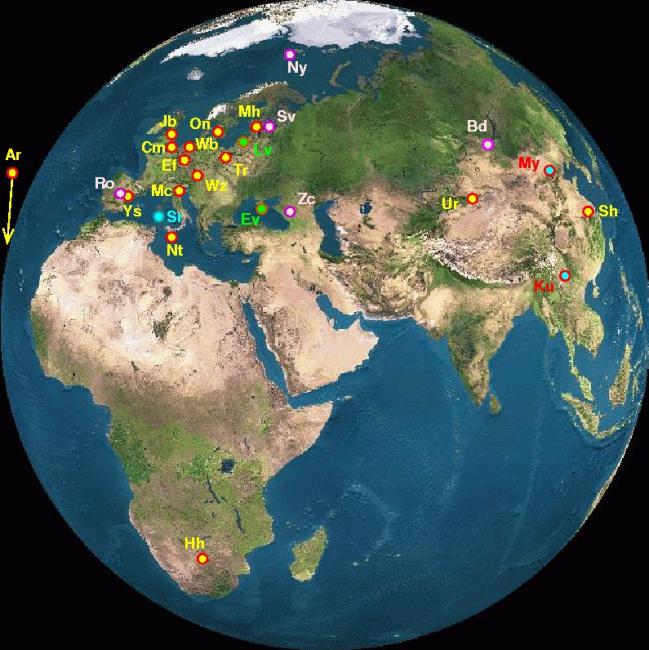 The EVN is a distributed network of radio telescopes located across the EU and beyond. EVN telescopes located within the EU include: Effelsberg (DE), Jodrell Bank and Cambridge (UK), Westerbork (NL), Onsala (SE), Medicina, Noto and SRT (IT), Yebes (ES), Torun (PL), Metsähovi (FI) and Irbene (LV). When conducting EVN observations, the participating telescopes operate as a single entity. Signals from each telescope are combined together at a central processing facility at the Joint Institute for VLBI in Europe (Dwingeloo, NL) for correlation. There are additional EVN telescopes in Russia (3), China (2), South Africa, and Puerto Rico. Joint observations with the UK MERLIN array and telescopes operated by NRAO (U.S.) are made on a regular basis.
The EVN is a distributed network of radio telescopes located across the EU and beyond. EVN telescopes located within the EU include: Effelsberg (DE), Jodrell Bank and Cambridge (UK), Westerbork (NL), Onsala (SE), Medicina, Noto and SRT (IT), Yebes (ES), Torun (PL), Metsähovi (FI) and Irbene (LV). When conducting EVN observations, the participating telescopes operate as a single entity. Signals from each telescope are combined together at a central processing facility at the Joint Institute for VLBI in Europe (Dwingeloo, NL) for correlation. There are additional EVN telescopes in Russia (3), China (2), South Africa, and Puerto Rico. Joint observations with the UK MERLIN array and telescopes operated by NRAO (U.S.) are made on a regular basis.
The European VLBI Network (EVN) is a cooperative effort among institutes in eight EU countries, plus Russia, China, South Africa, and Puerto Rico. From its formation in 1980 as a consortium of 5 European observatories, the EVN has led the way in bringing about effective inter-operation among European radio astronomy institutes. The telescopes in Russia, China and South Africa create EVN baselines longer than 8000 km, providing milliarcsecond (mas) resolution at cm wavelengths. The EVN also often observes in conjunction with the U.S. Very Long Baseline Array and the Green Bank telescope (operated by NRAO), providing significantly more baselines in the range of 6000-11000 km. EVN observations conducted in conjunction with the UK MERLIN array introduce baselines down to 20 km, providing sensitivity to more extended emission on the order of arcseconds.
The correlation facility for the EVN is located at the Joint Institute for VLBI in Europe (JIVE). The ASIC-based MarkIV correlator has processed EVN and global observations since 1999. It can correlate up to 16 telescopes, each at 1024 Mbps, and can compute a quarter-million complex lags. The flexibility of the correlator allows a range of observational goals, from high-sensitivity, full-Stokes continuum mapping to high spectral-resolution kinematics of celestial masers with velocity resolutions better than 0,1 km/s. The combination of high spectral resolution and short integrations permits mapping over a wide field of view. A new software correlator developed at JIVE surpasses the capabilities of the MarkIV processor (e.g., more than 16 telescopes simultaneously, arbitrarily fine spectral and temporal resolution, more accurate phase tracking) and permits astronomical applications not available on the MarkIV, such as pulsar binning/gating and multiple phase-centres within a single wide-field correlation.
The real-time e-EVN, in which telescopes stream data directly into JIVE via high-speed optical fibre for correlation, rather than record onto disks for subsequent shipping, has continued to mature over the past few years. Data rates of 1024 Mbps are now routine and reliable. The principal advantages of the e-EVN lie in the far shorter turn-around time from observations to the receipt of the correlated data (the PI typically can access their data within hours of the end of the observations) and in more frequent observing opportunities (typically one 24hr period per month in addition to the main observing sessions). Target-of-opportunity (ToO) observations are also more flexible via e-EVN. These capabilities are unique to the e-EVN, and enable it to be used as a dynamic instrument in which transient and flaring sources may be meaningfully studied at a resolution of a few mas, and VLBI observations may be coordinated with other instruments at other wavelengths.
View EVN in a larger map
|
Contact:
Dr. R. Campbell
e-mail: campbell [at] jive [dot] nl
JIVE
Oude Hoogeveensedijk 4
7991 PD Dwingeloo
The Netherlands
JIVE website
EVN website
|